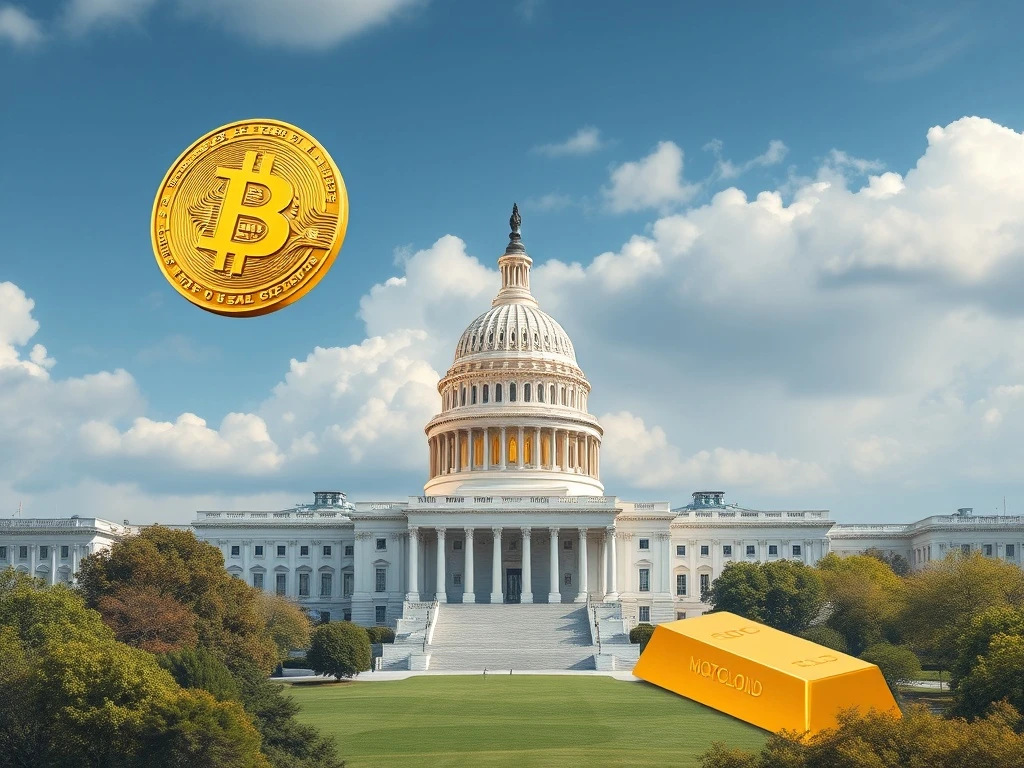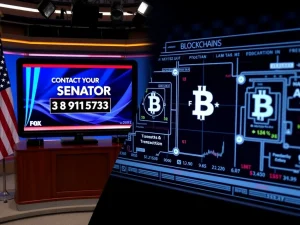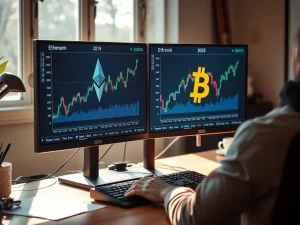Bitcoin Price Surges: US Unveils Revolutionary Strategic Reserve, Pushing Past $118,000

The cryptocurrency world is abuzz with monumental news: Bitcoin’s price surge has pushed it past the $118,000 mark. This impressive rally comes amidst groundbreaking developments, most notably the United States’ announcement of plans to establish a strategic Bitcoin reserve. This isn’t just another price pump; it signals a profound shift towards the mainstream acceptance and institutional integration of digital assets. For anyone watching the crypto space, this is a moment that demands attention.
The Unprecedented Bitcoin Price Surge: What’s Driving the Momentum?
Bitcoin’s journey to over $118,000 in early July 2025 has captivated global markets. This significant milestone wasn’t achieved in a vacuum. Several factors converged to create this powerful upward momentum, turning heads from Wall Street to Main Street.
First, the psychological barrier of $118,000 itself is critical. Breaking past such a significant level often signals strong buyer confidence and can trigger further upward movement. Technical analysts have pointed to the formation of a ‘bullish flag’ or ‘pennant’ consolidation pattern. These patterns typically suggest that after a strong price move, a period of consolidation occurs before another upward breakout, indicating sustained buying interest rather than a speculative flash.
On-chain data further reinforces this optimistic outlook. Bitcoin’s realized capitalization, a metric reflecting the aggregate value of all coins at the price they last moved, has soared past $1 trillion. This indicates robust underlying demand and a healthy network, showing that a significant amount of capital is held in Bitcoin at higher price levels. Even a notable $9 billion BTC sale by a Satoshi-era whale, which briefly introduced volatility, was absorbed by the market with remarkable resilience, underscoring the depth of current demand.
Historically, July has often shown positive returns for Bitcoin, and this trend appears to be reinforcing the cryptocurrency’s alignment with institutional and policy-driven market dynamics. The current Bitcoin price surge is a testament to both technical strength and fundamental shifts.
Unpacking the US Strategic Bitcoin Reserve: A Game Changer?
Perhaps the most impactful news driving Bitcoin’s recent rally is the U.S. government’s announcement of plans to establish a US Bitcoin Reserve. This move represents a pivotal moment, signaling a shift in how major global economies view and potentially integrate digital assets into their national financial strategies.
What exactly does a ‘strategic Bitcoin reserve’ entail? Imagine it akin to a nation’s gold reserves or foreign currency holdings, which are used to stabilize the economy, manage currency value, and provide a buffer against financial shocks. A Bitcoin reserve would serve a similar purpose in the digital age, aiming to:
- Solidify U.S. Leadership: By embracing Bitcoin as a strategic asset, the U.S. aims to position itself at the forefront of crypto innovation and policy.
- Stabilize Investor Confidence: Government-backed reserves, coupled with regulatory clarity, can significantly reduce perceived risks for investors, encouraging broader participation.
- Benchmark Digital Assets: Such a reserve could set a precedent, influencing how other nations and major financial institutions approach digital assets, potentially establishing Bitcoin as a global standard for digital value.
This initiative is reportedly part of broader pro-crypto policies under the Trump administration, which includes a formal national crypto policy framework. While details are still under development, this framework is expected to outline guidelines for treating Bitcoin as a legitimate reserve asset. The implications for central banking approaches to digital assets are profound, sparking global debates about the future of financial systems.
Catalyzing Crypto Institutional Adoption: Who’s Benefiting?
The establishment of a US Bitcoin Reserve is a powerful endorsement that could significantly accelerate crypto institutional adoption. For years, institutional investors and hedge funds have cautiously explored the cryptocurrency space. Now, with a major government signaling its strategic intent, the floodgates may open further.
Why are institutions increasingly allocating capital to Bitcoin? Their motivations are multifaceted:
- Hedge Against Macroeconomic Uncertainties: In an era of evolving Federal Reserve policy stances, inflation concerns, and geopolitical instability, Bitcoin is increasingly viewed as a decentralized, scarce asset that can act as a hedge against traditional market volatility.
- Diversification: Adding Bitcoin to a diversified portfolio offers exposure to a new asset class with potentially uncorrelated returns to traditional equities and bonds.
- Legitimacy and Regulation: As regulatory clarity improves and governments like the U.S. begin to integrate Bitcoin into their own strategies, the perceived risk for large institutions diminishes, making it a more viable investment option.
This move is expected to encourage even more pension funds, endowments, corporate treasuries, and asset managers to consider Bitcoin. It transforms Bitcoin from a speculative, fringe asset into a legitimate component of a modern, diversified investment strategy. The ripple effect could be substantial, drawing in trillions of dollars in capital that previously remained on the sidelines.
Decoding Bitcoin Market Analysis: Bullish Signals and Potential Hurdles
Beyond the headline-grabbing price, a deeper Bitcoin market analysis reveals a complex interplay of technical indicators, on-chain metrics, and macroeconomic factors. While the current sentiment is overwhelmingly bullish, it’s crucial to understand the nuances and potential challenges ahead.
Technical indicators, such as the bullish flag mentioned earlier, suggest strong underlying buying pressure. The $118,000 level, which has historically acted as a psychological barrier, now serves as a critical support level. Its resilience will be key in determining if this surge is a sustained bull market or a temporary spike. Traders are closely watching for continued consolidation above this level to confirm further upward trajectory.
On-chain data, which provides insights into the actual network activity, paints a picture of robust health. Beyond realized capitalization, metrics like the increasing number of active addresses and a reduction in Bitcoin held on exchanges indicate that more users are holding their Bitcoin for the long term, rather than preparing to sell. This ‘HODLing’ behavior reduces selling pressure and supports higher prices.
However, challenges persist. Sustained momentum will heavily depend on the ongoing development of regulatory clarity, particularly regarding the specifics of the U.S. national crypto policy framework and the reserve’s execution details. Short-term volatility is always expected in crypto markets as traders adjust to new information, take profits, and react to global economic shifts, including upcoming Fed rate decisions. While the trend favors continuation, investors should remain prepared for price fluctuations.
The Future of Bitcoin: Redefining Global Finance?
The U.S. initiative reflects a broader global trend of legitimizing cryptocurrencies as critical asset classes. This strategic shift has profound implications for the future of Bitcoin and the global financial landscape. By aligning policy with market realities, governments aim to foster innovation while mitigating risks associated with unregulated digital assets.
Bitcoin’s potential role as a reserve asset, akin to gold or foreign currencies, could redefine central banking approaches worldwide. It challenges traditional notions of monetary policy and asset management, pushing nations to consider digital assets in their strategic reserves. This could lead to:
- Increased Liquidity and Stability: As more institutions and governments hold Bitcoin, its market liquidity could deepen, potentially reducing extreme volatility over time.
- New Financial Products: The legitimization could spur the creation of more sophisticated financial instruments and services built around Bitcoin.
- Global Financial Integration: Bitcoin could become a more integrated part of international trade and finance, facilitating cross-border transactions and potentially challenging existing remittance systems.
However, the success of this reserve strategy will hinge on its execution. Details regarding its management, acquisition, and utilization remain undisclosed. Policymakers will need to navigate complex issues like security, energy consumption, and the potential impact on traditional financial markets. Despite these complexities, the trajectory suggests a future where Bitcoin is not just an alternative investment but a foundational component of global finance.
Conclusion: A New Dawn for Digital Assets
The surge of Bitcoin past $118,000, catalyzed by the U.S. government’s bold move to establish a strategic Bitcoin reserve, marks a truly historic moment. This isn’t merely a fleeting price spike; it’s a powerful signal of Bitcoin’s evolving status from a niche digital currency to a recognized strategic asset on the global stage. The accelerated pace of institutional adoption, coupled with supportive policy frameworks, is setting the stage for a future where digital assets play a fundamental role in national economies and international finance. While challenges remain, the current trajectory points towards an exciting and transformative era for Bitcoin and the broader cryptocurrency ecosystem. The world is watching as this new chapter unfolds, promising to redefine how we perceive and utilize value in the digital age.
Frequently Asked Questions (FAQs)
1. What is a strategic Bitcoin reserve?
A strategic Bitcoin reserve is a holding of Bitcoin by a national government, similar to how countries hold gold or foreign currencies. Its purpose is to stabilize financial markets, support national economic policy, and potentially act as a strategic asset for future economic stability and innovation in the digital realm.
2. How does a US strategic Bitcoin reserve impact Bitcoin’s price?
The establishment of a US strategic Bitcoin reserve is seen as a highly bullish development. It signals official legitimacy and adoption, which can significantly increase investor confidence, attract more institutional capital, and reduce perceived risk, thereby driving up demand and price.
3. What does “institutional adoption” mean for Bitcoin?
Institutional adoption refers to the increasing investment and integration of Bitcoin into the portfolios and operations of large financial entities like hedge funds, asset managers, corporations, and even governments. It signifies a shift from retail-dominated speculation to more stable, long-term investment by major players, lending greater legitimacy and stability to the market.
4. Are there risks associated with Bitcoin’s current surge?
Yes, while the current surge is driven by strong fundamentals, risks persist. These include potential short-term volatility as traders take profits, regulatory uncertainties (especially concerning the specifics of the reserve’s implementation), and broader macroeconomic shifts. Investors should always conduct their own research and consider market risks.
5. How might this US policy affect global financial systems?
This US policy could redefine central banking approaches to digital assets globally. It might encourage other nations to explore similar reserve strategies, potentially leading to increased international cooperation on crypto regulation, new global financial frameworks, and a more integrated digital asset economy. It challenges traditional views on what constitutes a reserve asset.
6. What is the significance of Bitcoin’s realized capitalization?
Bitcoin’s realized capitalization is a key on-chain metric that values each Bitcoin at the price it was last moved. When realized capitalization exceeds a significant threshold, like $1 trillion, it indicates that a large amount of capital is held in Bitcoin at higher price levels, suggesting strong conviction among holders and a healthy, resilient network that can absorb selling pressure.










